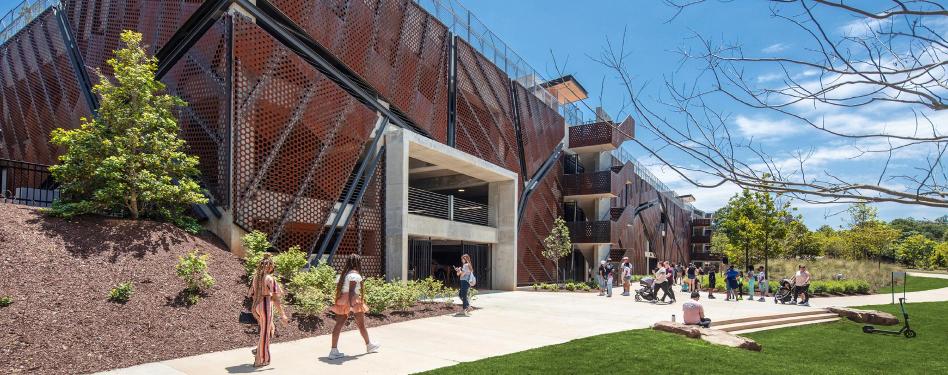
Feature image: The SITES Gold and LEED Silver Grant Park Gateway in Atlanta. Photo credit: Dorian Sky.
More than 370 registered and certified SITES projects—spanning 23 countries, 41 U.S. states and the District of Columbia—are focused on enhancing biodiversity. These projects, covering 1.3 billion square feet (120.8 million square meters), range from university campuses, hotels and resorts, government facilities, and public parks to commercial headquarters and mixed-use developments.
Administered by GBCI and complementary to LEED, SITES certification promotes sustainable and resilient land development and can be used on development projects with or without buildings to enhance biodiversity, mitigate and adapt for climate change, and improve resilience while also improving public health, conserving resources and reducing waste and pollution. The need for a more regenerative land development model has never been more important than now.
The vital importance of biodiversity
Biodiversity, a truncated version of “biological diversity,” refers to the variety of life on Earth, from bacteria to entire ecosystems. We depend on biodiversity for food, medicine, energy, clean air and water, and even economic success. Half of the world’s GDP is moderately or highly dependent on nature and its services (known as ecosystem services), which is reflected in the foundational framework for the SITES rating system.
However, today more than one million species and their ecosystems are threatened with extinction. In 2019, the Intergovernmental Science-Policy Platform on Biodiversity and Ecosystem Services (IPBES) Global Assessment Report on Biodiversity and Ecosystem Services, the most comprehensive such report ever completed, kick-started global concern about our impact on the planet.
“The health of ecosystems on which we and all other species depend is deteriorating more rapidly than ever. We are eroding the very foundations of our economies, livelihoods, food security, health and quality of life worldwide,” said IPBES chair Sir Robert Watson in the announcement. “The report also tells us that it is not too late to make a difference, but only if we start now at every level, from local to global.”
Advancing the global agenda at COP 16
Biodiversity loss, land degradation and climate change are also inextricably connected, and so are many of the solutions. Land and the oceans absorb more than half of all carbon emissions, and conservation and restoration of these natural spaces could provide roughly one-third of the mitigation efforts needed in the next decade.
The landmark Kunming-Montreal Global Biodiversity Framework passed in December 2022 at the U.N. Convention on Biodiversity biannual meeting (known as COP 15), laying the groundwork for a path forward. Enacting this vision will require global transformation that addresses the five main threats to biodiversity:
- Land and water use
- Invasive species
- Pollution
- Overexploitation of resources
- Climate change
This historic agreement aims to guide global action for nature toward 2030 through four goals for 2050 and 23 targets for 2030.
USGBC working to advance biodiversity solutions
This year, USGBC will participate in COP 16 to engage with this global community to advance practical solutions for the built environment to reverse biodiversity loss and enhance biodiversity value. Taking place in Cali, Colombia, from Oct. 21 through Nov. 1, COP 16 will feature three main areas of focus:
- Further developing the Kunming-Montreal Global Biodiversity Framework (also known as the "Biodiversity Plan") for global implementation
- Collaborating for improved resource mobilization and technical cooperation to invest in nature
- Accelerating progress on access and benefit sharing
USGBC will highlight the impact we are having through LEED and SITES. Learn more in our report, "Real Estate and Biodiversity: What You Need to Know."
Leveraging SITES to connect with the Global Biodiversity Framework
Many of the credits in the SITES rating system are directly correlated to 23 targets found in the Global Biodiversity Framework, such as
- Target 1: Plan and Manage All Areas to Reduce Biodiversity Loss
- Target 6: Reduce the Introduction of Invasive Alien Species by 50% and Minimize Their Impact
- Target 8: Minimize the Impacts of Climate Change on Biodiversity and Build Resilience
- Target 12: Enhance Green Spaces and Urban Planning for Human Well-Being and Biodiversity
Nature-based solutions are key to supporting a healthy, biodiverse future. They are mentioned specifically in Target 8 and are a driving feature of the SITES rating system.
As a comprehensive guide to land development, SITES is uniquely positioned to address the targets outlined in the Global Biodiversity Framework, guiding property owners, developers, designers and others in prioritizing biodiversity within their projects. SITES is an ideal tool to ensure accountability and verify implementation of nature-based solutions as well as celebrate leadership and innovation.
The SITES integrative design process brings all necessary voices to the table throughout the design and development process, allowing biodiversity to be part of the decision-making process from the onset. Key strategies include
- Working with stakeholders and site users to incorporate local knowledge into designs and to promote benefit sharing.
- Requiring the conservation of existing critical, rare, sensitive and healthy areas such as floodplains, wetlands and threatened and endangered species habitats.
- Prohibiting the use of invasive plants and requiring a multiyear invasive species control and management plan.
- Emphasizing the importance of healthy soil throughout the process, including protection and restoration tactics, so it can provide a foundation for vegetation and habitat.
- Prioritizing restoration using native plants and creating habitat where land has been degraded.
- Promoting sustainable material sourcing to protect ecosystems and their communities, in addition to strategies to reduce pollution, waste and resource consumption.
- Sharing guidance and education for contractors and site managers on protecting and managing healthy soil and vegetation.
SITES projects are making a difference
Through SITES, projects maximize their value by enhancing local biodiversity, mitigating climate change, bolstering resilience and protecting critical ecosystems. Explore certified SITES projects that have creatively addressed biodiversity and water management on their own sites.
If you are attending COP 16, we’d like to know! Please reach out to us.
